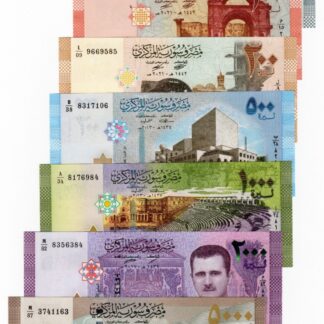Description
7 pieces all UNC
£50 P-NEW TBB-636 (2021 version of 2009 P-112) “Clay Tablets”
– Ugarit alphabet on ancient cuneiform clay tablets from Ebla.
– Reverse: Al-Assad National Library in Damascus and statue of Hafez al-Assad.
£100 P-NEW TBB-633 (2019-21 version of 2010 P-113) “Bosra”
– Bab el-Hawa (Gate of the Wind), the Western Gate, built from black basalt stone, situated at the western end of the Decumanus Maximus, Bosra’s main thoroughfare. The Bosra Amphitheatre.
– Reverse: the dome of the Treasury of Damascus in the Umayyad Mosque. Central Bank of Syria on the Sabaa Bahrat Square (Square of the Seven Fountains) in Damascus. Ancient Silver Antoninianus coin of Roman Emperor Philip the Arab, Marcus Julius Philippus Augustus, Philip I, or Philippus Arabs (Reign: 244-249).
£200 2009 P-114 “Norias & Mosque”
– In the middle- The Norias of Hama (Arabic: نواعير حماة) are a number of Norias (“wheels of pots”) along the Orontes River in the city of Hama, Syria. Only seventeen of the original Norias remain. They are mostly unused now and serve an aesthetic purpose. They were called “The most splendid Norias ever constructed”. The Norias of Hama were submitted as a tentative World Heritage Site by the Syrian Arab Republic in June 1999.
– At right- The Nur Al-Din Mosque (Arabic: جامع نور الدين) or Jami Nur al-Din is a Zengid-era mosque in Hama. It was founded by Nur al-Din in 1163-64 CE. It also contained a historic Minbar from the same date, which is now held at the local Hama Museum. The mosque was profoundly damaged in the 1982 shelling of the city and subsequently restored to its current state.
– Reverse: Dark brown on light brown underprint, windowed security thread and iridescent stripe near centre.
— Decorated Ceiling of the southern niche, at the Temple of Bel at ancient Palmyra. The decoration of this ceiling was purely ornamental; in 1753 its design became known in Europe through engravings based on drawings by Giovanni Battista Borra.
—The Temple of Bel/Baal was an ancient temple located in Palmyra.
£500 2014 P-115 “Opera House”
– Opera house.
– Reverse: paintings of artists and musicians
£1000 2015 P-116 “Amphitheater”
– Bosra amphitheater
– Reverse: mosaic of grape harvest in Roman ruins of As-Suwayda, olive branches.
£2000 2017 P-117 “Assad”
– Dark purple print on multishade light purple and blue underprint; black serial number in both eastern Arabic and western numerals.
– In the middle – The Umayyad Mosque (Arabic: الْجَامِع الْأُمَوِي), also known as the Great Mosque of Damascus (Arabic: جَامِع بَنِي أُمَيَّة الْكَبِير), located in the old city of Damascus, is one of the largest and oldest mosques in the world. The mosque is also important in Islam because of its historical and eschatological reports and events associated with the mosque.
– At right – Bashar Hafez al-Assad (born 11 September 1965) is a Syrian politician who had been the 19th president of Syria from 17 July 2000 until the fall of his government on 8 December 2024. In addition, he was the commander-in-chief of the Syrian Armed Forces and regional secretary of the Arab Socialist Ba’ath Party’s branch in Syria.
-Reverse: People’s Council, Damascus
£5000 2019–2024 P-118 “Soldier”
– Syrian soldier saluting next to the Flag of Syria.
– Reverse: fresco from the Baalshamin Temple and Roman amphitheater in the ancient city of Palmyra.


Reviews
There are no reviews yet.